Maidstone, Kent
Up to 1834
The 1725 edition of An Account of Several Workhouses... included a report dated October 26, 1724, stating that:
But beside the Poor maintain'd in the Workhouse, there are many others who receive weekly Pay from the Parish; and therefore our Poor's Rate for this Year, will amount to about five hundred and thirty Pounds; and yet, notwithstanding this Abuse of maintaining so many of the Poor by a weekly Allowance of Money, we are very great Gainers by our Workhouse. For of the two immediate Years before the House was built, the Poor's Rate in one of them came to nine hundred and twenty nine Pounds; and in the other, to one thousand and sixty two; and thereabout it had stood for many years. So that you will observe, that tho' we receive but half the Benefit of our Workhouse, by maintaining but half our Poor in it, yet we save pretty near five hundred Pounds a Year, under so irregular and faulty a Management. For the Advantage of a Workhouse does not only consist in this, that the Poor are maintained at less than half the Expence which their weekly Pay amounted to, but that very great Numbers of lazy People, rather than submit to the Confinement and Labour of the Workhouse, are content to throw off the Mask, and maintain themselves by their own Industry. And this was so remarkable here at Maidstone, that when our Workhouse was finished, and publick Notice given, that all who came to demand their weekly pay, should immediately be sent thither, little more than half the Poor upon the List came to the Overseers to receive their Allowance.
...
As there are many in our Workhouse who are past their Labour, their Business is to teach the Children to read, to clean the House, attend in the Kitchen, and do other such Offices as their Age and Strength admit of. The ancient People go to Church every Day, the Children and working People only on Wednesdays and Fridays; but they always have constant Prayers in the House, and continual Reading the Scriptures. None are suffer'd to walk into the Town without Leave, and the Children are seldom seen, even at the Door, but have a Spot of Ground for their Diversion behind the House.
An insciption over the workhouse door read:
Ut industriam potius quam segnitiem promoveat;
Ut ab impensa vix tolerabili (iis tamen
Sublevandis impari) parochiam exoneret;
Hoc, quod spectas, aedificium
Ex singulari sua munificentia posuit
THO. BLISS, arm. 1720.
This roughly translates as:
To promote industry in preference to sloth;
To disburden the parish from an expense scarcely bearable
(inadequate however for those worthy to be relieved);
This building, which thou beholdest,
he out of his own bounty erected.
THOS. BLISS, Esq., 1720.
Beneath, a smaller slab was inscribed:
Neither should he eat."
2 THESS. iii. chap., 10 verse.
This early workhouse is believed to have stood on Knightrider Street in Maidstone and in a Parliamentary report of 1776-7 was noted as being able to accommodate up to 150 inmates. It was demolished in 1842 to build the Baptist Church which is still there.
In 1771, another workhouse was built near the junction of Heath Road and Stockett Lane at Coxheath.
A parliamentary survey in 1777 recorded workhouses in operation at Bearsted (for up to 27 inmates), East Farleigh, Linton and Loose (100), Marden (40), Maidstone (150), Marden (40), Staplehurst (45), and Yalding (30).
After 1834
"Coxheath Poor Law Union" officially came into existence on 15th October 1835, although in 1836 was renamed Maidstone Union. Its operation was overseen by an elected Board of Guardians, 18 in number, representing its 15 constituent parishes as listed below:
County of Kent: Bersted [Bearsted], Boughton Monchelsea, Barming, East Farleigh, Hunton, West Farleigh, Linton, Loose, Maidstone (4), Marden, Nettlested [Nettlestead], Otham, Staplehurst, Teston, Yalding.
The population falling within the Union at the 1831 census had been 28,969 with parishes ranging in size from from Teston (population 255) to Maidstone itself (15,387). The average annual poor-rate expenditure for the period 1833-5 had been £24,043 or 16s.7d. per head of the population.
The Maidstone Union Workhouse was built in 1836 at a site to the south of Heath Road in Coxheath. It was was designed by John Whichcord although clearly based on Sir Francis Head's Plan of a Rural Workhouse for 500 Persons published by the Poor Law Commissioners the previous year. The design was of plain brick construction and comprised a large quadrangle enclosed by two-storey buildings, a plan used in other Kent Unions such as Blean. A further building, thought to be the workhouse school, were erected nearby at the north side of Heath Road. The workhouse location and layout are shown on the 1895 OS map:
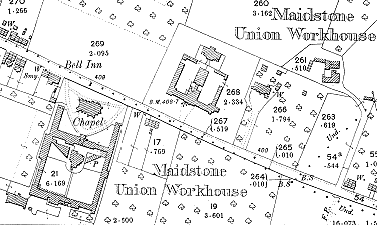
Maidstone site, 1895
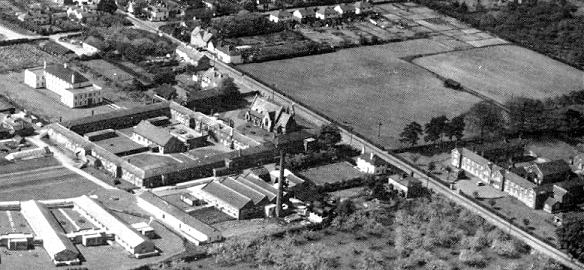
Maidstone workhouse site from the south-east, c.1960.
Courtesy of John Mason
The entrance block at the north of the building, featured a central gateway, with the governor's rooms and committee room on one side, and kitchens on the other. The dormitory blocks, which were referred to as 'cottages' measured 15 feet by 10 feet, lit by a small window. There was a single ground-floor privy on each side of the courtyard.
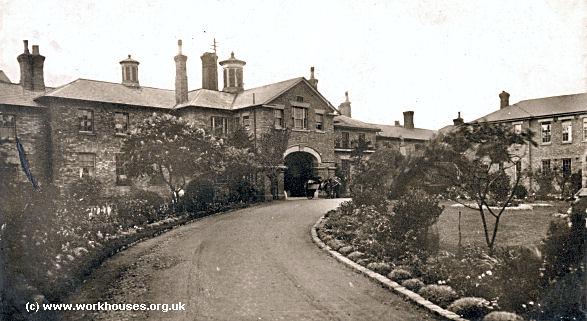
Maidstone workhouse site from the north-east, c.1905.
© Peter Higginbotham.
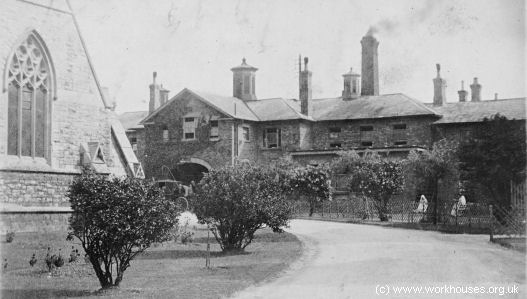
Maidstone entrance block from the north-west, early 20th century.
© Peter Higginbotham.
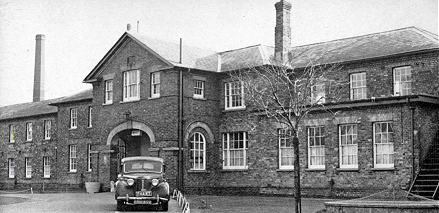
Maidstone entrance block from the north-west, c.1950.
Courtesy of John Mason
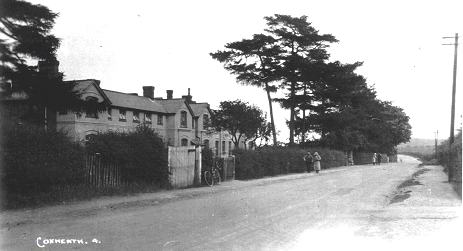
Maidstone workhouse school from the south-west, c.1900.
Courtesy of John Mason
An ornate gothic-style chapel, built from local stone, was erected at the north of the workhouse in 1883. It was dedicated as Holy Trinity "To the Glory of Almighty God, Father, Son and Holy Ghost".
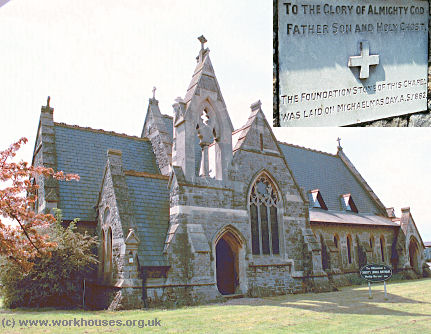
Maidstone chapel from the north-east, 2001.
© Peter Higginbotham.
Between 1868 and 1899, the Master and Matron of the workhouse were Charles John Moss his wife Charlotte Sophia.
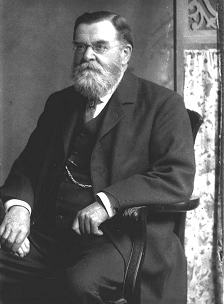
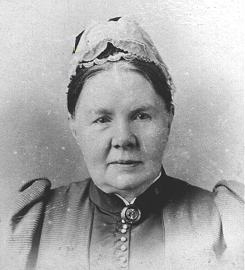
Charles John and Charlotte Sophia Moss.
Courtesy of John Mason
The picture below, kindly contributed by Lesley Trotter, is believed to be of the workhouse staff in the early 1900s.
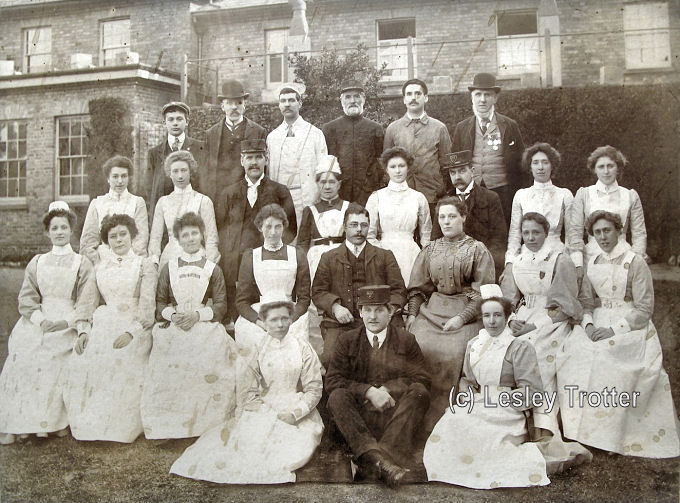
Maidstone workhouse staff, early 1900s?
© Peter Higginbotham.
The workhouse later became Linton Hospital. The former school site was later known as John Day House and provided accommodation for the elderly mentally infirm. All the buildings except the chapel were demolished in about 1994.
Staff
Inmates
Records
Note: many repositories impose a closure period of up to 100 years for records identifying individuals. Before travelling a long distance, always check that the records you want to consult will be available.
- Kent History and Library Centre, James Whatman Way, Maidstone, Kent ME14 1LQ Holdings include: Guardians' minutes (1835-1930); Births (1836-1939); Deaths (1840-1941); Creed registers (1888-1948); Register of lunatics (1859-1923); Punishments book (1896-1931); Workhouse medical relief books (1925-28); etc.
- Canterbury Cathedral Archives, The Precincts, Canterbury, Kent CT1 2EH. Baptisms and burials (1840-52).
Bibliography
- Higginbotham, Peter Workhouses of London and the South East (2019)
Links
- None.
Unless otherwise indicated, this page () is copyright Peter Higginbotham. Contents may not be reproduced without permission.


